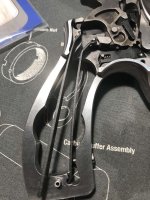I just installed a Wilson spring kit (along with a lock delete) in a new production 686 2.5".
I used the 12# trigger return spring and noticed the main spring is shorter than OEM. See attached photo. The Wilson is installed.
I have the DA trigger adjusted down to just over 6 pounds but have not been able to fire it yet.
I'm in the process of switching over from Winchester to Federal primers to get consistant ignition. I noticed a few 'no fires' on another 686 6" that I had some action work done on. It ran flawless with Win primers before. Also noticed a similar issue on a lever action I had worked on. He suggested using Federal primers with the lighter hammer spring.
Has anyone else installed a similar kit in their revolver and did you have any ignition issues? What weight did you set the DA pull to?
I have another spring kit I was considering installing on a 29-5 I just picked up.
I used the 12# trigger return spring and noticed the main spring is shorter than OEM. See attached photo. The Wilson is installed.
I have the DA trigger adjusted down to just over 6 pounds but have not been able to fire it yet.
I'm in the process of switching over from Winchester to Federal primers to get consistant ignition. I noticed a few 'no fires' on another 686 6" that I had some action work done on. It ran flawless with Win primers before. Also noticed a similar issue on a lever action I had worked on. He suggested using Federal primers with the lighter hammer spring.
Has anyone else installed a similar kit in their revolver and did you have any ignition issues? What weight did you set the DA pull to?
I have another spring kit I was considering installing on a 29-5 I just picked up.

